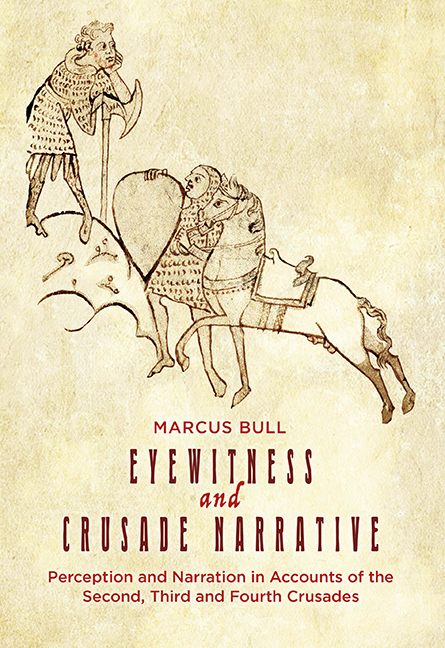 Eyewitness and Crusade Narrative
Eyewitness and Crusade Narrative Book contents
- Frontmatter
- Dedication
- Contents
- Acknowledgements
- Abbreviations
- Introduction: Medieval and Modern Approaches to Eyewitnessing and Narratology as an Analytical Tool
- 1 Memory and Psychological Research into Eyewitnessing
- 2 The Second Crusade: The De Expugnatione Lyxbonensi and Odo of Deuil's De Profectione Ludovici VII in Orientem
- 3 The Third Crusade: Ambroise's Estoire de la Guerre Sainte and Points of Comparison and Contrast
- 4 Geoffrey of Villehardouin's and Robert of Clari's Narratives of the Fourth Crusade
- Conclusion
- Bibliography
- Index
4 - Geoffrey of Villehardouin's and Robert of Clari's Narratives of the Fourth Crusade
Published online by Cambridge University Press: 12 February 2019
- Frontmatter
- Dedication
- Contents
- Acknowledgements
- Abbreviations
- Introduction: Medieval and Modern Approaches to Eyewitnessing and Narratology as an Analytical Tool
- 1 Memory and Psychological Research into Eyewitnessing
- 2 The Second Crusade: The De Expugnatione Lyxbonensi and Odo of Deuil's De Profectione Ludovici VII in Orientem
- 3 The Third Crusade: Ambroise's Estoire de la Guerre Sainte and Points of Comparison and Contrast
- 4 Geoffrey of Villehardouin's and Robert of Clari's Narratives of the Fourth Crusade
- Conclusion
- Bibliography
- Index
Summary
The sources for the Fourth Crusade are as rich as for the Third, if not richer. In addition to charter evidence for departing crusaders and newsletters sent home by some of the leading figures in the crusade army, we have several letters to and from Pope Innocent III as well as an apologia, the Gesta Innocentii Papae, written in 1206, which amongst other aspects of the pope's pontificate up to that point addresses his handling of the problems that the crusade had presented. In addition, there are formal records of some of the treaties and agreements that scaffold the story of the crusade, and narrative accounts that were either written by an eyewitness or capture the reminiscences of a former participant. The invaluable balancing function performed in the case of the Third Crusade by authors close to Saladin is, for the Fourth, principally assumed by a major Byzantine historian, Niketas Choniates, a high-ranking member of the aristocracy of service in the imperial government who was directly affected by the crusaders’ capture and sack of Constantinople in April 1204. Choniates's account of this turn of events is a famous set-piece that has done much to set the tone of modern sensibilities about the crusade's moral bankruptcy and negative cultural legacy.
There are significant gaps in the evidence, nonetheless. Crucially, there is no closely contemporary historiographical coverage from a Venetian perspective, an imbalance that undoubtedly contributed to the dim view of Venice's involvement in the crusade that characterized a great deal of scholarship in the nineteenth and twentieth centuries. It is only in recent decades that a more balanced assessment of the Venetian role has emerged, thanks to the work of scholars such as Donald Queller and Thomas Madden. We now have a better appreciation of the enormous costs that Venice incurred in building and equipping the large fleet that it contracted to supply for the crusaders, and of the various ways in which the Venetians’ reactions to events as they unfolded constantly came back to the implications and consequences of this central fact.
- Type
- Chapter
- Information
- Eyewitness and Crusade NarrativePerception and Narration in Accounts of the Second, Third and Fourth Crusades, pp. 256 - 336Publisher: Boydell & BrewerPrint publication year: 2018


